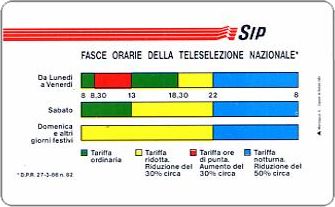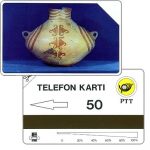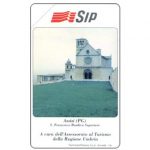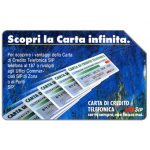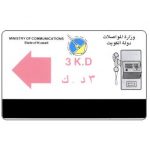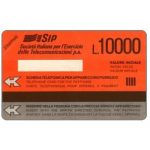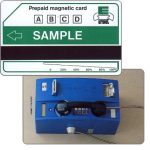On the occasion of the Turin Motor Show of 1987, held in April at the Palazzo delle Esposizioni, six new experimental telephone cards are sold to the public, three of 5000 and three of 10,000 lire, which represent an evolution of Urmet technology already used for the “red” series. Side A presents the magnetic strip placed horizontally as in the “red”, but with an increased height. Also appear the new writing “Telephone card” in black on a blue background and, for the first time, the concept of limited validity over time of the card, represented by the words “Validity June 87”. While side A is the same for all six cards (except, of course, for face value), on the B side various services offered by SIP are promoted, such as the alarm (114), the latest Rai news (190), urgent calls (197), the practicability of roads (194) and meteorological forecasts (1911). The last of the six cards instead shows a diagram with the cost of phone calls during the different hours of the day and during the different days of the week; they are the so-called “Fasce Orarie” (time slots). The SIP managers, looking for an idea to illustrate the B side of the new ordinary series, which would replace the “red” series, choose the latter subject: the “Fasce Orarie”, which will accompany Italians for more than seven years, from about half, from 1987 until 30 June 1994 with two issues for South Tyrol.
The first Fasce Orarie, say non-experimental, have validity 31.12.89, and are equipped with the additional writing “Servizi 1” on the B side. They can be cataloged 4 different types, or 6 if we also consider the numbering of the lots. However, they are almost always not magnetized.
Another group of Fasce Orarie with a deadline of 31.12.89, those of the so-called ABCD series, consists of 8 cards, 4 of 5,000 and 4 of 10,000 lire. In these cards the numbering (OCR) is preceded by the letters A, B, C, D. They are often non-magnetized and fairly easy to find. The deadline 31.12.89 appears on 10 other cards (2 of which for Alto Adige), 4 printed by Mantegazza and 6 by Pikappa: the latter are almost all quite rare. The time slots with the new deadline 30.06.90 include three pieces that represent the key values of the whole series; these are the three cards issued by Technicard System, two from 5000 lire and one from 10,000; particularly rare (and quoted), cross and delight of collectors who, not knowing them with precision, often confuse them with the later ones of Technicard Polaroid; the only element that differentiates them is in fact the company logo, placed vertically on the right on side B. The deadline 30.06.90 appears in total on 12 cards, five of which are rare both new and used.
The subsequent issues 31.12.90 are 8, not counting the subtypes, including 5 for Alto Adige. Then there is the deadline 30.06.91 with 4 cards, and 31.12.91 with 18 different types, some of which in my opinion quite undercut in the catalogs, such as those that, presenting the watermark in relief, are not easily available. With this deadline, five cards are issued for South Tyrol, three of which are wrong because the night rate is indicated in the legend as the ordinary rate; error corrected in the last two. The cards with expiration 30/06/92 have runs of tens of millions for some of them; consequently their availability is very easy as used; 6 different types are known.
With the deadline 31.12.92, the series ends up in practice because this is the last date to be printed for the Italian Fasce Orarie; the subsequent ones with dates 30.06.93 and following will be made only for South Tyrol. For the first time on the A side, a novelty, constituted by the additional writing “the card is not refundable”, and this means that all the cards with this validity, for each of the three companies that produce them, have a double version (without , or with the additional writing); therefore, the different types are 18, not counting the subtypes. Then there are 6 other cards with validity 30.06.93, 31.12.93 and 30.06.94, realized as already said only for South Tyrol.
Thus closes a series that for period of use and for total circulation can be compared to the series Siracusana in the field of stamps of the Italian Republic; the duration of about 7 years and the circulation of many millions of pieces have made it very popular both in terms of users and collectors. However it remains a very difficult task to put together a complete series, albeit vast, of Fasce Orarie, as some types have had a circulation of only 25,000 pieces largely dispersed with use (such as the famous 10,000 lire Technicard System).






